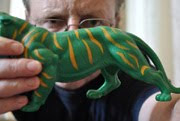Conceptual art refers to work where ideas are paramount and traditional notions of form and aesthetics are secondary. At least I think that’s what it means. Through its association with the Young British Artists in the 1990s, it is now commonly taken to encompass all contemporary art that does not rely on the traditional skills of painting and sculpture. You know, that Damien Hirst and his elk (or rather shark).
However, the term ‘conceptual art’ originally referred to works that could be constructed by anyone simply by following a set of written instructions (see Sol LeWitt). In the extreme form, this art-as-instructions/blueprint/DNA removed the need for objects altogether – it could exist in the mind alone. Lawrence Weiner summarised the ethos of this original conceptual art: “Once you know about a work of mine, you own it. There’s no way I can climb inside somebody’s head and remove it.”
Looking at conceptual art in this way, the gallery, museum, art market and wealthy collector all become redundant. So it’s ironic (or not) that the term ‘conceptual art’ is now probably most closely associated with the megabuck art factory that is Damien Hirst, whose artistic philosophy can be summed up as “how can I make more money?”.
In the original spirit of conceptual art, I now offer you this work:
“99 meditations on Princess Diana”
Most days I walk past a small stone memorial to Princess Diana. This photo is your starting point.

There are always flowers adorning the monument – bouquets from various local supermarkets such as Asda and Morrisons. These nosegays usually have the price tag left on, which seems a bit odd to me, but there you go. Some days there are one or two bunches, sometimes more.
Now this is where you come in – I want you to imagine another 99 photos on different days, with different flowers, different labels, and in various states of decay. Now examine the 99 photos in your mind. What do they say about our modern relationships with celebrity, shared experiences and conspicuous grief. Are they a wise meditation on fame and the media? Have they challenged your previously held assumptions about the life of the princess?
Congratulations! You now own the work “99 meditations on Princess Diana”. You can pay me if you want for this work via Paypal (email for details) but maybe I should be paying you for renting out the space in your head. Moving swiftly on...








